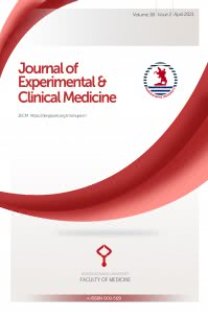Çocukluk çağı nefrotik sendromu: 230 olgunun değerlendirilmesi
Bu çalışmada Ondokuz Mayıs Üniversitesi Tıp Fakültesi Çocuk Sağlığı ve Hastalıkları Anabilimdalı Pediatrik Nefroloji ünitesinde Ocak 1986 ile Aralık 1998 yıllan arasında geçen 12 yıllık süre içinde izlenen 0-17 yaş grubunda nefrotik sendrom (NS) tanısı alan 230 hasta retrospektif olarak incelendi. Çalışmaya dahil edilen NS'lu hastalarda Uluslararası Çocuk Böbrek Hastalıkları Çalışma Grubunca (ISKDC) kabul edilen tanı kriterleri kullanıldı. Etiyolojik nedenlere göre primer (idiyopatik) ve sekonder NS olarak sınıflandırılan olguların klinik ve laboratuvar bulguları incelendi. Olguların %77.8'i primer, %17.4'ü sekonder NS olarak belirlendi, %4.8 olguda ayrım yapılamadı. Olguların %39.1'u kız, %60.9'i erkekti ve kız/erkek oranı 1/1.6 olarak saptandı. Minimal lezyonlu NS (MLNS) düşünülerek kortikosteroid tedavisi verilen hastaların (n: 127) %77.8'i sterolde yanıt verdi. Sterolde yanıt veren hastaların %51'inde relaps gözlendi ve relaps olgularının %29.4'u nadir relaps, %10.7'si sık relaps şeklindeydi. Hastaların %3.9'u ise sterolde bağımlı olarak saptandı. Amiloidozis 27 hastada saptandı ve sekonder NS'un en sık nedeni idi. Gelişen komplikasyonlar içinde en sık enfeksiyonlar görüldü. Toplam 230 NS'lu hastanın %57.4'ü remisyona girdi, %5.6'ı eksitus oldu ve %10.4'ünde kronik böbrek yetmezliği (KEY) gelişti. Yaş, cins, etiyolojik dağılım, tedaviye yanıt ve prognoz yönünden incelenen nefrotik sendrom tanısı almış 230 olgunun bulguları ülkemiz verilen ve literatür bulgularıyla karşılaştırıldı.
Nephrotic syndrome in childhood: Retrospective evaluation of 230 cases
In this study, we evaluated 230 children (0 to 17 years old) with nephrotic syndrome (NS) who admitted to the Department of Pediatrics of Ondokuz Mayıs University between January 1986 to December 1998, retrospectively. The diagnostic criteria of International Study of Kidney Diseases of Children (ISKDC) were used to define the patients in this study. Patients were classified into two groups according to etiology as primary and secondary NS. Clinical and laboratory findings of all cases were examined. It is observed that 77.8% of the cases had primary and 17.4% had secondary NS, 4.8% of them could not be classified. 39.1% of the patients were female and 60.9% of them were male. Female/male ratio was 1/1.6. Steroid responsive cases consisted 77.8% of the cases with minimal change NS (MCNS). 51% of the patients with steroid responsive MCNS developed one or more relapses. Among the relapses, rare and frequent relapses were 29.4% and 10.7%, respectively. 3.9% of the patients with MCNS were steroid dependent. Amyloidosis was diagnosed in 27 patients and it was the most common cause of secondary NS. The most frequent complication was infection. In 230 patients, 57.4% went to remission, 5.6% died and 10.4% progressed to chronic renal failure. These findings were evaluated according to age, sex, etiology, response to treatment, prognosis and compared with national data and the literature.
